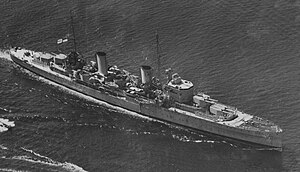HMAS Perth (D29)
This article includes a list of references, related reading, or external links, but its sources remain unclear because it lacks inline citations. |
 HMAS Perth in 1940
| |
| History | |
|---|---|
United Kingdom / Australia | |
| Namesake | City of Perth, Western Australia |
| Builder | Portsmouth Naval Dockyard |
| Laid down | 26 June 1933 |
| Launched | 27 July 1934 |
| Acquired | 1939 (Australia) |
| Commissioned | list error: <br /> list (help) 15 June 1936 (HMS Amphion) 29 June 1939 (HMAS Perth) |
| Motto | "Floreat" (Let it flourish) |
| Fate | Sunk in action with Japanese destroyers and cruisers, Sunda Strait 1 March 1942 |
| General characteristics | |
| Class and type | Leander class light cruiser |
| Displacement | 6,830 tons (standard) |
| Length | 555 ft (169 m) (waterline) |
| Beam | 56 ft 8 in (17.27 m) |
| Draught | 15 ft 8 in (4.78 m) |
| Propulsion | list error: <br /> list (help) Parsons geared turbines Four shafts, 72,000 shp |
| Speed | 32.5 knots (60.2 km/h) |
| Range | list error: <br /> list (help) 7,400 nautical miles at 13 knots 1,920 nautical miles at 30.5 knots (56.5 km/h) |
| Complement | list error: <br /> list (help) 646 (35 officers, 611 enlisted men) 681 at time of loss (includes 6 RAAF, 4 civilians) |
| Armament | list error: <br /> list (help) 8 × 6 in MkXIII (4 × 2) 8 × 4 in MkXVI (4 × 2) 12 x 0.5 in Machine guns (3 × 4) 10 x 0.303 in machine guns (10 × 1) 8 × 21 in Torpedo tubes (2 × 4) |
| Aircraft carried | one seaplane; Seagull V A2-4 & A2-17, Supermarine Walrus L2234, L2298, & L2319. (Seagull V A2-4 survives at RAF Museum, Hendon) |
HMAS Perth (pennant number D29) was a Modified Leander class light cruiser which served with the Royal Australian Navy during World War II.
Perth, the first ship to be named after the city of Perth, was the first of its class to be modified for Australia. The Modified Leander class is sometimes known as the "Perth class" or the "Amphion class", after the ship's original name, HMS Amphion.
Construction
Perth was originally laid down by HM Dockyard at Portsmouth, England on 26 June 1933, launched on 26 July 1934 by the Marchioness of Titchfield, completed in July 1936, and commissioned at Portsmouth on 15 June 1936 as HMS Amphion.
The ship was purchased by the Australian government and commissioned into the Royal Australian Navy as HMAS Perth at Portsmouth on 29 June 1939. The ship's company was made up of sailors from HMAS Adelaide, which had been placed into reserve a month previously.
Operational history
Perth began her career by serving in the Mediterranean Theatre. She participated in the Battle of Cape Matapan, and was involved in the evacuation of Greece in April 1941.
On 26 February 1942, Perth arrived at Surabaya from Tanjong Priok, under the command of Captain Hector Waller, along with the Royal Navy cruiser Exeter, the Netherlands light cruiser Java, and the British destroyers Electra, Jupiter, and Encounter. On 27 February, Perth joined a group of ABDA cruisers and destroyers, commanded by Dutch Rear Admiral Karel Doorman onboard the cruiser HNLMS De Ruyter, that left Surabaya to intercept a Japanese convoy approaching from the Makassar Strait. The ensuing action was the Battle of the Java Sea.
Perth was one of only three cruisers to survive the Battle of the Java Sea. Along with the United States Navy heavy cruiser USS Houston, Perth was ordered to sail through the Sunda Strait to Tjilatjap. Perth was torpedoed by Japanese destroyers during the Battle of Sunda Strait on 1 March 1942, and sank with the loss of 350 of her crew and three civilians. The surviving crew were captured by the Japanese; 106 died in captivity before the end of World War II.
